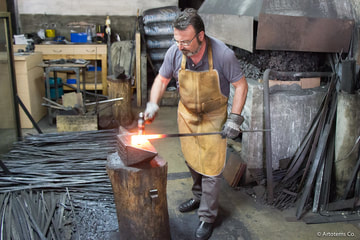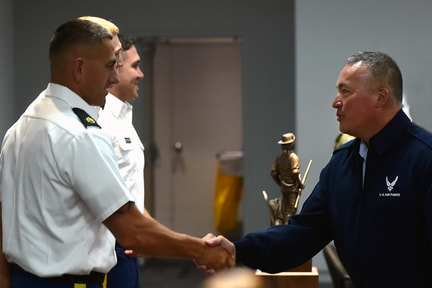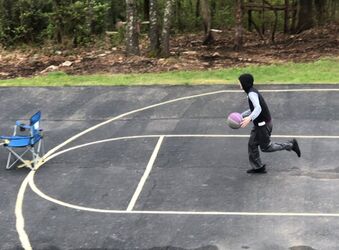Bridging Leadership Lessons from the Workplace and Those Experiences Shaping Today's Youth and Tomorrow's Leaders
 A popular saying in sports today is that iron sharpens iron. Meaning that competition can be used to push each other to improve, and you need to surround yourself with others who want to get better. When both people are committed to growth, they recognize challenges as opportunities and not obstacles. Competitive people can be found everywhere in life. It’s obvious when you see them participating in an athletic event, but they are also recognizable when playing cards, sitting in a classroom or at the workplace. I absolutely love having those competitive people on my teams - whether I’m coaching sports or working on a project at work. They want to win and winning is typically fun! Most people who have been part of a successful team know what collaboration and cooperation to work towards an aligned goal feels like. Knowing that your teammate will support you and have your back when the challenges get tough, helps drive you forward with greater energy than you would have faced it alone. I have found it to be easier to focus the competitive spirit of a person than to try and instill it in someone to whom it is not natural. There is a line between being competitive and being overly competitive. While it typically is easy to see, sometimes the competitiveness is simply misdirected. Instead of competing alongside or with your team, they start competing against a teammate. Their desire to “win” as they define it becomes greater than the “win” as you, the leader or the team has defined. As leaders, coaches, and parents it’s our job to recognize when the focus of their competitiveness changes and work to realign their goals and understand their role on the team. If you are a member of the team and you recognize that a teammate is more focused on them winning than the team winning, then it is also on you to help create an environment in which the person can contribute and feel the benefit of the team win to the same degree that they would feel the individual win. When people have a shared vision of success, it’s easier to align and use the 3 Pillars of Impact to get there. How to Make Sure You Compete With and Not Against Teammates Communicate - The 3 Pillars are founded on the ability to communicate. If you can’t deliver expectations, or positively challenge, or show appreciation, the team is destined for failure before they have even begun. Share your vision and ask others about their vision. Share feedback and ask questions. If you have opened dialogue when times are good, that door will be open if you need to talk when times are tough. Humility - Nobody is bigger than the team. The Hall of Fame and Super Bowl winning Coach, Tony Dungy, asked in his book Mentor Leader, “Am I prepared to have great success and not get any credit for it?” If you are more worried about your individual success than the team success, then maybe you might be contributing to the problem. Don’t add to the need of another to compete with you. Encourage - Everyone likes to win. To be recognized. Encourage the behavior that is needed. Compliment them when they play the role that the team needs them to play. Competitive people especially need to know that they contribute. While it may be against their nature to play a different role, if they can see the value and feel the recognition and reward of performing that role, then they will jump in headfirst. Align - Talk to everyone about the shared vision. Reinforce the roles in which people are at their best but more than that, talk about how the roles help the team move towards the vision. If everyone is talking about the vision, it’s much easier to correct misalignments and reinforce that it is the vision of the team and not an individual. Demonstrate - Walk the walk. Be the teammate and coworker that you want to see in others. Follow the principles and work towards the vision. It’s easy to point out the faults in others while not living up to the same values. It’s normal to see people jockey for position. Friendly competition can be helpful and invigorating when used appropriately and kept in perspective. But when our egos get involved and we start measuring our worth and value versus others is when it becomes dangerous to success. It is not always an ego or jealousy situation but instead part of a person’s own self-assessment. In my post Why Your Opponent is Your Best Teacher, I pose the question of why you run your race. To beat the person next to you or to run it as fast as you can. It’s understandable that individuals can lose sight of the greater objective when they have a competitive nature. They misplace their focus as well as mistaking the feeling of competition or challenge as something to be defeated instead of used to fuel continued growth. Whether you are the leader or a member of the team, alignment of the individuals on the team to the shared vision as well as the acceptance of the roles each team member plays towards that success will be vital to mutual success. Competing alongside and not against each other is how teams will have success Beyond Today.
0 Comments
 (This post was originally titled, Husker Chant, and was posted on September 10, 2009.) While I am in no way a Husker fan or supporter, the Head Coach of my son's 5th/6th grade football team is a Husker fanatic. Complete with the Tommy Frazier reference on his license plates. (Kids, go google Tommy Frazier and Nebraska football and you will understand.) The coach introduced a pre-game ritual that he borrowed from his beloved Huskers. It is a powerful message to send to our nation's future about development, fairness, and sportsmanship. It doesn't ask for an advantage… just an opportunity. A chance to grow and develop to allow them to compete. It basically talks about the right way to win and if you lose, you still need to keep things in perspective and thank your opponent for competing and congratulate them on their victory. Typically, the Coach would lead, and the team would repeat the line. The first paragraph was spoken solemnly and with respect. The last paragraph is shouted with emotion enabling the young players to feed off it and as they gather in the huddle with the speech rising to the climax, the last sentence is emphasized with an exclamation point after each word. Then a simple breakdown of "(Team Name) on 3" and they would hit the field. This year, a couple of our "seniors" (a.k.a. 6th graders) have taken upon themselves to lead this ritual at the end of practice, assuming the leadership role that had previously been performed by the head coach. Another sign of the development of not only young players, but young citizens that understand the power of leadership. THE HUSKER PRAYER Dear Lord, the battles we go through life, We ask for a chance that’s fair. A chance to equal our stride, A chance to do or dare. If we should win, Let it be by the code, With our heads and our honor held high. If we should lose, We will stand by the road And cheer as the winners go by. Day by Day! We get better and better! A team that can't be beat! WON'T! BE! BEAT! Our young people are always watching, learning, and growing. They are nourished by what they are fed and what they consume. Each day we have opportunities to provide “healthy” options that will help them grow into successful, well-balanced, contributors to our society. Finding those moments to interject life lessons and build excitement for those around them have lasting impacts Beyond Today.  Most people are familiar with the English proverb, “the road to hell is paved with good intentions.” I have written about this topic several times with the most direct being Taking Action is Key to Breaking out of the Planning Loop. In these cases, I typically am talking about achieving a goal or finishing a project that is impactful to you and your company/family. Today, I’m looking at the Impact you make in relationships with others, whether coworkers, family, friends, or complete strangers. Those moments in time where a simple gesture or word can create a ripple across multiple people. This anomaly became known as the butterfly effect based on the observations and writings of Edward Lorenz. I am that “good intentions” guy. I think about sending a card to someone during times of grief - but I never do. I think I should reach out and give a person a call or text congratulating them on the promotion - but I don’t. I have these great intentions, these feelings inside of me that I know I should act on but because of fear, laziness, or anxiety, I don’t. The book Leadership and Self-Deception by the Arbinger Institute talks in detail about Self-Betrayal in a very relatable story format. It was a punch in the gut when I read the book. The authors define Self-Betrayal as “an act contrary to what I feel I should do for another.” The book goes on to state that when you betray yourself, you start to look at the world in a way that justifies your actions/feelings or your self-betrayal. Then, when you start to see the world in a self-justified way, your view of reality becomes distorted. Wow. That’s me. A guy who thinks he is a good friend but in reality, tends to fall short of meeting my expectations. I intend to be a good friend, but I get busy and justify why I don’t reach out, stay in touch and follow-thru with what I know I should do. I bring this up to encourage you to read the 3 books from the Arbinger Institute. They talk about Outward vs Inward mindsets. In the book The Outward Mindset, they write “...someone with an outward mindset holds himself accountable both for his own actions and performance, and for his impact on others actions and performance.” When I went back and re-read the highlighted portions of the book to support this post, I was blown away how my One Word for the year, IMPACT, was so prevalent throughout the book. I saw first-hand in October of 2021 how the willingness to put yourself out there can have a positive impact on others. A coworker of mine was feeling stressed and struggling at work. I was at a conference in St. Louis and had exchanged some texts and emails during the day. The frustration was understandable and very evident in our communication. On my way home, I decided to make the call (yes, I actually took ACTION instead of just thinking about it!) and we talked. I shared my perspective and feedback that I had received from others on the value this employee brought to the company. He thanked me and I was happy that I finally chose to act instead of intending to act. The next day, my coworker and I were talking when he asked me to shut the door. He proceeded to thank me and the sincerity in his voice was evident. It wasn’t easy for him, and it wasn’t easy for me to receive it either. But at that moment, the power of sharing oneself was never more evident to me. Seeing the way it made him feel and in turn how I felt was very powerful. Two days later, during a Teams video meeting, I received a chat message from a different co-worker. He shared fond memories from the early days of working together in the company. Unbeknownst to him, that was exactly what I needed at that moment in time as I was struggling with my own positivity and mindset. I sincerely thanked him for reaching out and sharing and honestly, I probably made him a little uncomfortable as I’m sure he couldn’t comprehend the IMPACT those messages had on me. If my coworker, two days earlier, had not shown the heartfelt appreciation, I probably would have blown off the comments with a funny response or some thumbs up. But knowing how it made me felt, I knew I had to show this person the same courtesy and respect. German philosopher Friderich Nietzche said “A ‘thing’ is the sum of its effects.” The effect of taking action instead of just intending to take action has a tremendous IMPACT on the three people in those two different interactions. Who else was impacted by the ripple of reaching out, choosing to share a little bit of yourself and making sure that your IMPACT is felt Beyond Today. I originally posted this Sep. 8, 2009, and it is just as valid today. It is applicable across any sport, but the concept can also be applied to the workplace. Continuous improvement doesn’t have to be boring. We use fun 2 second lean videos to share easy improvements to our workflow so that we keep things fresh, but also buckle down with additional training on formal problem-solving techniques. Continued reading, webinars, conferences all have a mix of fun and education. Choose to be great.  When you go outside with the basketball to improve your game are you practicing or shooting around? Do you realize that there is a difference? For the average player or for the recreational player, nope, not really a difference. For the great players...well, there is a huge difference! To help clarify, let's define the two activities. Shooting around is just what the words mean: you go out to the court, and you start shooting around. Typically, you don't have a plan of activities, an expected outcome or time limit. Your main purpose is just to put the ball into the basket and enjoy yourself in the process. Hey, this is a lot of fun and probably describes most kids playing basketball today. Now, when I say practice, I am talking about practicing as an individual like you practice with the team. There should be a "practice plan" just like most good coaches have in place before their practice. They have drills, times, and goals for why each drill is being performed. You can do the same thing when you are practicing basketball alone. What type of drills will you work on today? Will you just shoot baskets, or will you mix in ball handling and conditioning? How many shots will you take? Left-handed? Right-handed? Post moves? Free throws? 3 pointers? Let's be honest, practices are typically not as fun as shooting around which is why, as kids, it is important to do both! One day, just shoot around for 30 minutes or an hour. Play a game in your mind where you hit the game winning shot against Kobe and the Lakers to win the NBA title 98 to 97. Enjoy playing the game and work on your moves. Play at game speed. Then the next day, go to work. Put the time in on the little things, the fundamentals, that will make you a better player. That will separate you from your competition. Set goals for shots made and then give yourself a reward or punishment (push-ups or sprints) when you don't meet those goals. Combine your drills to keep things from getting boring and allow you to work on multiple aspects at one time. Perform the drills that you do at team practice or your individual workouts using a "defender" (a.k.a. trashcan, chair, etc.,) and then explode for a lay-up, power drive, or jump shot. Do this from multiple spots on the court. You have probably heard the saying that somebody somewhere is practicing basketball and when you meet and all things are even, that person will win. Will you be that person? I use a saying with my team, "Practice hard. Play hard." This is our break from the huddle and a mantra that I use to challenge my players to improve their game and to practice at game speed...not just shoot around. The courts are full of kids who shoot around and only shoot around. Great players practice. Will you be great? |
AuthorTom Brown - a husband and a father who is simply trying to make a difference. Using my experience as a Manufacturing Executive to connect leadership from the boardroom to the hardwood to help teams grow and develop to make a difference in the lives of others. Archives
May 2024
Categories |
Proudly powered by Weebly

 RSS Feed
RSS Feed

